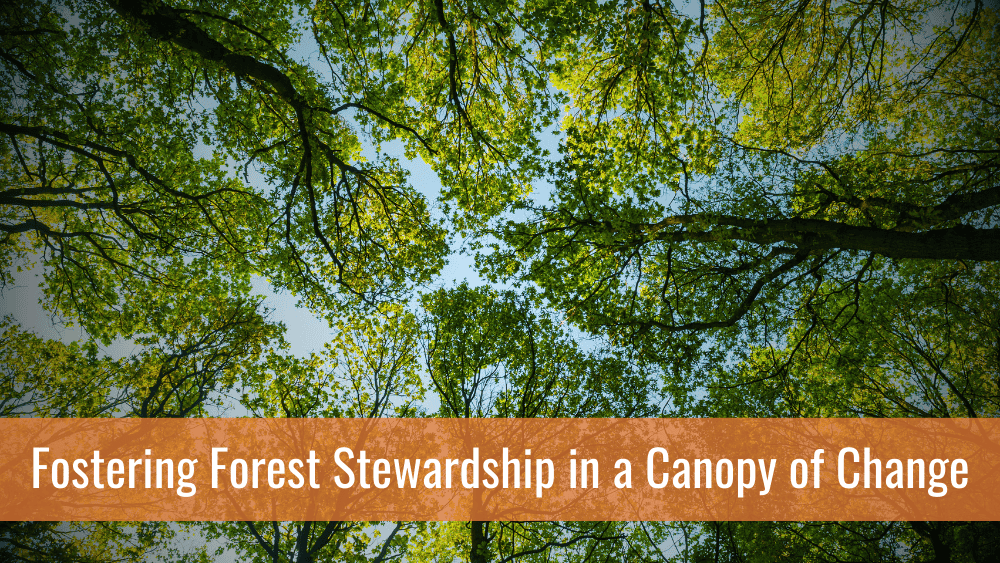
Current Issue

Roots and Resiliency: Fostering Forest Stewardship in a Canopy of Change
As the world studies climate change, the significance of the forests becomes even more pronounced. Worldwide, forests are experiencing impacts from extreme weather events due to a changing climate, which will result in changes to individual species and the ecosystem as a whole. To understand long-term impacts, we must understand the roots of forest systems to anticipate how forests may respond to changes and how we can help these ecosystems remain sustainable.
Fostering Forest Stewardship in a Canopy of Change is a call to action that calls on us to examine current forest practices, identify where vulnerabilities may lie, and identify necessary adaptations. In every rustle of the leaves and whisper of the wind, there lies an opportunity to create a harmonious partnership with the natural environment and original stewardship practices. To create viable solutions for future resilient forests, one will have to examine traditional ways and knowledge of stewardship, as well as scientific innovations and techniques.
2025 Current Issue Study Guide (NCF-Envirothon)
Key Topics & Learning Objectives
- Key Topic 1: Climate Change Projections
- Describe the causes of climate change, including the greenhouse effect.
- Explain the impacts of climate change on the environment, as well as social and economic impacts both locally and globally.
- Explain the concept of Canada’s Representative Concentration Pathway models and what they imply for the future climate.
- Differentiate types of climate models and the various components that enable models to project future conditions.
- Key Topic 2: Forest Health in a Changing Climate
- Explain how globalization has enabled the spread of invasive insect species and impacted the world’s forests.
- Describe how wildfire impacts the hydrology, wildlife, and soils of forest communities.
- Describe the conditions of drought as it relates to forest ecosystems, and identify how increasing drought severity and frequency impacts global forests.
- Explain the biology and impacts of typical forest insect pests such as Mountain pine beetle, Spruce beetle, Spruce budworm, Forest tent caterpillar, Emerald ash borer, and Asian longhorn beetle.
- Describe biology and impacts of typical forest diseases such as Western gall rust, Armillaria root rot, needle casts and needle rusts.
- Describe how the prevalence and spread of forest pests and diseases are expected to shift with climate change.
- Key Topic 3: Inherent Rights of Indigenous Peoples to Land Stewardship
- Identify differences between Indigenous worldviews and Western worldviews regarding land stewardship.
- Identify and summarize the core themes within the United Nations Declaration on the Rights of Indigenous Peoples (UNDRIP).
- Explain why some countries did not sign on to the original adoption of UNDRIP in 2007 and why some of those countries joined UNDRIP later.
- Describe how land-based learning and Traditional Knowledge systems can contribute to improved land use, forest management, and mitigation strategies.
- Describe how Indigenous stewardship and traditional ecological knowledge could help meet global conservation goals.
- Key Topic 4: Vulnerability Assessments and Adaptation Strategies
- Describe a forest vulnerability assessment, including its purpose and steps.
- Assess forest conditions and apply climate change adaptation strategies to support sustainable forest management.
- Analyze the benefits and drawbacks of various climate change adaptation strategies for forests, including assisted species migration, selective breeding, and /or afforestation.
- Define adaptive capacity in relation to vulnerable flora and fauna of forest communities.
- Distinguish how various ecozones face differing levels of vulnerability and explain which ecological factors drive this vulnerability.
- Key Topic 5: Legislation and Regulations
- Describe how governments determine if forest harvesting levels will be sustainable in the future with climate change.
- Explain how natural disturbances such as wildfires, windstorms, droughts, and hail storms impact the forest industry’s total annual harvest quota.
- Describe how forest certification can be used as a global tool to manage forests sustainably.
- Identify key takeaways of the 2015 Paris Agreement and how the commitments made influence forest sustainability.
- Explain the main goals of the 2022 Kunming-Montreal Protocol and the positive impacts this agreement could have on forest sustainability.
- Key Topic 6: The Boreal Forest
- Describe an ecozone or ecological land classification, and identify how different types are anticipated to shift based on climate change projections.
- Identify ecosystem services provided by boreal forest ecosystems, including environmental, economic, social, and cultural values.
- Differentiate the types of wetlands found in the boreal forest, explain their importance, and describe the anticipated effects from a changing climate on these ecosystems.
- Identify boreal forest-dependent species, and explain how climate change may threaten their populations.
- Analyze the wildfire regime in the boreal forest and describe how it is changing in response to climatic shifts.
Current Issue: Recommended Resources (Texas)
- Article: Imperiled in the Wild, Many Plants May Survive Only in Gardens, Yale Environment 360
- Pamphlet: What Climate Change Means for Texas, US Environmental Protection Agency
- Report: Assessment of Historic and Future Trends of Extreme Weather in Texas, 1900-2036, Texas A&M University
- Video: 21st Century Texas: Climate, Water, Science, and Society, Native Prairies Association of Texas Fayette Prairie Chapter
- Video: Impact on Climate Change and Ecological Restoration In the Real World, Native Prairies Association of Texas Fayette Prairie Chapter
Oral Presentation
Teams are provided all materials needed to prepare their oral presentation. Presentation materials and procedures will be emailed to registered teams.






